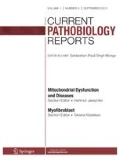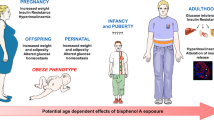Abstract
Purpose of Review
In women, breast cancer is the second most common cause of death. Endocrine-disrupting chemicals (EDCs) can interfere with hormone signaling, possibly linking to cancer. Among these, estrogen-mimicking endocrine disruptors (EEDs) infiltrate the human diet and are known to bind to estrogen receptors.
Recent Findings
We reviewed recent literature (n = 13 papers) examining associations between dietary intake of EEDs and breast cancer incidence. Collectively, this sample of investigations suggest a positive correlation, including bisphenol A (BPA) (0.4–4.2 μg/kg-bw/day), phytoestrogens (sum of genistein and daidzein; 1000–3000 μg/kg-bw/day), and pesticides, specifically dichlorodiphenyltrichloroethane (DDT) (0.03 μg/kg-bw/day) and atrazine (0.033–0.0123 μg/kg-bw/day collectively). Evidence for linkages between breast cancer and exposure to additional EDCs/EEDs from dietary intake was weaker, e.g., phthalates and parabens whose exposure routes were dominated by inhalation and dermal absorption.
Summary
Body burdens with EEDs potentially causing physiological disruption were demonstrated for BPA (50 μg/kg adipose tissue/day), phytoestrogens (300 μg/kg adipose tissue/day), and DDT (250 μg/kg adipose tissue/day) and atrazine (25,000 μg/kg adipose tissue/day). Opportunities for reducing unwanted dietary exposures to estrogen mimics were evaluated.
Similar content being viewed by others
References
Papers of particular interest, published recently, have been highlighted as: • Of importance
Burks H, Pashos N, Martin E, Mclachlan J, Bunnell B, Burow M. Endocrine disruptors and the tumor microenvironment: a new paradigm in breast cancer biology. Mol Cell Endocrinol. 2017;457:13–9.
Diamanti-Kandarakis E, Bourguignon J-P, Giudice LC, Hauser R, Prins GS, Soto AM, et al. Endocrine-disrupting chemicals: an Endocrine Society Scientific Statement. Endocr Rev. 2009;30:293–342.
Roy JR, Chakraborty S, and Tandra R Chakraborty OJ Published: 2009. Puberty in humans – a review. Med Sci Monit.
Reaves DK, Ginsburg E, Bang JJ, Fleming JM. Persistent organic pollutants and obesity: are they potential mechanisms for breast cancer promotion? Endocr Relat Cancer. 2015;22:R69–86.
• Iqbal J, et al. Dietary isoflavones, the modulator of breast carcinogenesis: current landscape and future perspectives. Asian Pac J Trop Med. 2018;11:186 Research on the estrogen-mimicking effects of dietary isoflavones that could potentially promote breast cancer development is somewhat novel and sparse. Iqbal et al. wrote a fantastic review that discussed previous work or findings from history that was never followed up on and elaborated in good detail.
Cdc.gov (2018) Basic information about breast cancer. https://www.cdc.gov/cancer/breast/basic_info/index.htm. Accessed 11 December 2018.
Geens T, Aerts D, Berthot C, Bourguignon J-P, Goeyens L, Lecomte P, et al. A review of dietary and non-dietary exposure to bisphenol-A. Food Chem Toxicol. 2012;50:3725–40.
Mnif W, Hassine AIH, Bouaziz A, Bartegi A, Thomas O, Roig B. Effect of endocrine disruptor pesticides: a review. Int J Environ Res Public Health. 2011;8:2265–303.
• Maqbool F, Mostafalou S, Bahadar H, et al. Review of endocrine disorders associated with environmental toxicants and possible involved mechanisms. Life Sci. 2016;145:265–73 Maqbool et al. explained endocrine disorders, such as cancer, obesity, and thyroid, and related them to possible environmental toxicants after reviewing multiple epidemiological and experimental studies. There were figures which described the direct human impact that these chemicals have on the body and described in detail the mechanism of each toxicant studied such as BPA, DDT, atrazine, parabens, and phthalates.
• Rietjens IMCM, Louisse J, Beekmann K. The potential health effects of dietary phytoestrogens: potential health effects of dietary phytoestrogens. Br J Pharmacol. 2017;174:1263–80 Rietjens et al. explained in detail the mechanisms by which dietary isoflavones, specifically genistein and dadzein, operate inside the human body and the potential they have for promoting breast cancer. Disruption at the estrogen receptor, mimicking estrogen, and upregulating enzymes such as aromatase were all discussed in describing how phytoestrogens should be further examined in regards to tumor progression and breast cancer promotion.
Epa.gov (2010) Bisphenol A action plan. https://www.epa.gov/sites/production/files/2015-09/documents/bpa_action_plan.pdf. Accessed 10 October 2018.
• Giulivo M, de Alda ML, Capri E, et al. Human exposure to endocrine disrupting compounds: their role in reproductive systems, metabolic syndrome and breast cancer. A review. Environ Res. 2016;151:251–64 This review highlights a detailed overview of specific EEDs (BPA, phthalates, parabens) outlining their exposure routes, how they affect the human body, and mechanisms of physiological disruption, particularly on the reproductive system and ultimately leading to breast cancer. This information was important during the early research stages of writing this review to gather a detailed perspective on which EEDs to focus on.
Efsa.europa.eu (2004) https://www.efsa.europa.eu/en/press/news/040929. Accessed 18 October 2018.
• Patisaul HB. Endocrine disruption by dietary phyto-oestrogens: impact on dimorphic sexual systems and behaviours. Proc Nutr Soc. 2017;76:130–44 This review particularly investigated the relationship dietary phytoestrogens have on neurological disorders but still described in detail how dietary phytoestrogens pose a negative threat to human health. This was one of the first papers reviewed in the beginning of the research process that discussed phytoestrogens. The information obtained helped to pave the way for finding more studies that involved examining dietary isoflavones, such as genistein and dadzein.
Atsdr.cdc.gov (2002) Public health statement DDT, DDD, and DDE. https://www.atsdr.cdc.gov/phs/phs.asp?id=79&tid=20. Accessed 11 December 2018.
Alavanja MCR, Ross MK, Bonner MR. Increased cancer burden among pesticide applicators and others due to pesticide exposure: pesticides exposure and cancer. CA Cancer J Clin. 2013;63:120–42.
Sungur S, et al. Determinatıon of bisphenol a migrating from canned food and beverages in markets. Food Chem. 2014;142:87–91.
Cdc.gov (2018) Dichlorodiphenyltrichloroethane (DDT) factsheet. https://www.epa.gov/ingredients-used-pesticide-products/ddt-brief-history-and-status. Accessed 11 December 2018.
Epa.gov (2018) Atrazine. https://cfpub.epa.gov/ncea/iris2/chemicalLanding.cfm?substance_nmbr=209. Accessed 11 December 2018.
Toxnet.nlm.nih.gov (2018) DDT. https://toxnet.nlm.nih.gov/cgi-bin/sis/search/a?dbs+hsdb:@term+@DOCNO+200. Accessed 11 December 2018.
Patisaul HB, Jefferson W. The pros and cons of phytoestrogens. Front Neuroendocrinol. 2010;31:400–19.
Messina M. Soy and health update: evaluation of the clinical and epidemiologic literature. Nutrients. 2016;8:754.
Kuhnle GGC, Dell’Aquila C, Aspinall SM, et al. Phytoestrogen content of foods of animal origin: dairy products, eggs, meat, fish, and seafood. J Agric Food Chem. 2008;56:10099–104.
• Halden RU. Plastics and health risks. Annu Rev Public Health. 2010;31:179–94 Highly cited review paper presenting an overview of toxic human exposures and potential avenues to reduce plastic use and adverse health outcomes.
Epa.gov (1987) DEHP. https://cfpub.epa.gov/ncea/iris2/chemicalLanding.cfm?substance_nmbr=14. Accessed 18 October 2018.
Chang Y, Choue R. Plasma pharmacokinetics and urinary excretion of isoflavones after ingestion of soy products with different aglycone/glucoside ratios in South Korean women. Nutr Res Pract. 2013;7:393–9.
Ziaei S, Halaby R. Dietary isoflavones and breast cancer risk. Medicines. 2017;4:18.
Stanczyk FZ, Clarke NJ. Measurement of estradiol—challenges ahead. J Clin Endocrinol Metab. 2014;99:56–8.
Bowes DA, Halden RU. Theoretical evaluation of using wastewater-based epidemiology to assess the nutritional status of human population. Curr Opin Environ Sci Health. 2019;9:58–63.
Morgan M, Deoraj A, Felty Q, Roy D. Environmental estrogen-like endocrine disrupting chemicals and breast cancer. Mol Cell Endocrinol. 2017;457:89–102.
Mie A, Andersen HR, Gunnarsson S, Kahl J, Kesse-Guyot E, Rembiałkowska E, et al. Human health implications of organic food and organic agriculture: a comprehensive review. Environ Health. 2017;16:111.
Author information
Authors and Affiliations
Corresponding author
Ethics declarations
Conflict of Interest
Devin A. Bowes and Rolf U. Halden declare no conflict of interest.
Human and Animal Rights
All reported studies/experiments with human or animal subjects performed by the authors have been previously published and compiled with all applicable ethical standards (including the Helsinki declaration and its amendments, institutional/national research committee standards, and international/national/institutional guidelines).
Additional information
Publisher’s Note
Springer Nature remains neutral with regard to jurisdictional claims in published maps and institutional affiliations.
This article is part of the Topical Collection on Understanding the Pathogenesis and Predicting the Behavior of DCIS
Rights and permissions
About this article
Cite this article
Bowes, D.A., Halden, R.U. Breast Cancer and Dietary Intake of Endocrine Disruptors: a Review of Recent Literature. Curr Pathobiol Rep 7, 41–46 (2019). https://doi.org/10.1007/s40139-019-00199-1
Published:
Issue Date:
DOI: https://doi.org/10.1007/s40139-019-00199-1




